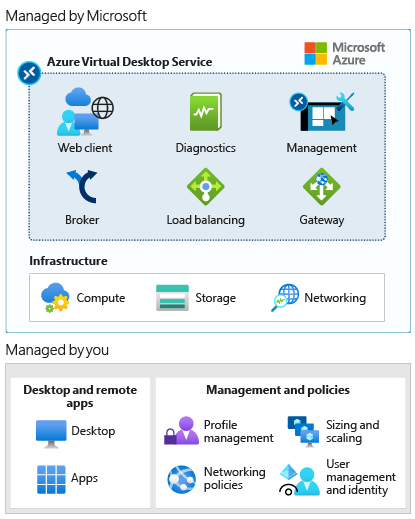We’ll learn how to use Azure Virtual Desktop to offer remote desktop and remote app experiences in Microsoft Azure in this article.
Azure Virtual Desktop
Azure Virtual Desktop is a cloud-based desktop and app virtualization solution by Microsoft. Azure Virtual Desktop is compatible with a variety of devices, including Windows, Mac OS X, iOS, Android, and Linux, and includes programs for accessing remote desktops and apps. Most recent browsers can also be used to access Azure Virtual Desktop-hosted experiences.
Best user experience with Azure Virtual Desktop
- Users can connect to Azure Virtual Desktop using any device connected to the internet.
- You can ensure that your session host virtual machines (VMs) are located close to apps and services that connect to your datacenter or cloud. As a result, users are able to stay productive while also avoiding longer load times.
- Because user profiles are containerized using FSLogix, user sign-in to Azure Virtual Desktop is extremely fast. The user profile container is automatically connected to the computing environment when a user signs in.
- Personal (persistent) desktops can enable individual ownership. For example, the engineering team can add or remove apps on a remote desktop without affecting other users.
Enhance security
- With Azure Active Directory, Azure Virtual Desktop enables centralized security management for user desktops (Azure AD). To safeguard user sign-ins, enable multifactor authentication. You can also restrict data access by giving users specific role-based access limits.
- The data and programs are separated from the local hardware and run on a distant server with Azure Virtual Desktop. As a result, the chance of sensitive information being left on a personal device is minimized.
- In both single and multi-session setups, user sessions are isolated.
Simplify management
- To manage resource access, Azure Active Directory and role-based access restrictions can be used.
- Have the ability to automate VM deployments, manage VM upgrades, and restore VMs in the event of a disaster.
- For monitoring and alarms, Azure Monitor is used. This allows administrators to spot problems using a single interface.
Manage performance
- On your VM host pool, there are options for load balancing users.
- You can set up load balancing to happen as people log in (breadth mode).
- You can save money by configuring your VMs for depth mode load balancing, which allocates all users to one VM before going on to the next.
- When inbound demand reaches a certain level, tools are provided to automatically provision extra VMs.
Deploy multi-session Windows 10
Windows 10 Enterprise multi-session is the only Windows client-based operating system that allows several concurrent users on a single virtual machine, and Azure Virtual Desktop lets you use it (VM). In comparison to Windows Server-based operating systems, Azure Virtual Desktop delivers a more consistent experience with greater application support.
How does Azure Virtual Desktop work?
Traditional Remote Desktop Services (RDS) or virtual desktop infrastructure (VDI) environments are more difficult to establish and operate than Azure Virtual Desktop. You won’t have to worry about setting up and managing servers and server roles like gateways, connection brokers, diagnostics, load balancing, and licensing.
The diagram below shows which services Microsoft manages and which you manage.

The following infrastructure, clients, and images are essential for Azure Virtual Desktop.
Infrastructure
Azure Virtual Desktop can be deployed in a cloud-only or hybrid environment.
For hybrid environments:
- An Azure Active Directory organization.
- A domain controller that’s synced with Azure Active Directory. You can configure this with one of the following:
- Azure AD Connect
- Azure Active Directory Domain Services (Azure AD DS)
- An Azure subscription that contains a virtual network that either contains or is connected to the Windows Server Active Directory or Active Directory Domain Services.
For cloud organizations:
- An Azure Active Directory organization.
- Azure AD DS.
- An Azure subscription that contains a virtual network that either contains or is connected to the Active Directory Domain Services.
The Azure VMs you create for Azure Virtual Desktop must be:
- Standard domain-joined, Hybrid AD-joined, or Azure AD-joined.
- Running one of the supported OS images.
The following Remote Desktop clients support Azure Virtual Desktop:
- Windows Desktop
- Web
- macOS
- iOS
- Android (Preview)
- Linux
Azure Virtual Desktop supports the following x64 operating system images:
- Windows 10 Enterprise multi-session, version 1809 or later
- Windows 10 Enterprise, version 1809 or later
- Windows 7 Enterprise
- Windows Server 2019
- Windows Server 2016
- Windows Server 2012 R2
When to use Azure Virtual Desktop
| Business need | Description |
| Security and regulation | Keep data and organizational resources safe while enabling the appropriate level of access by a variety of the organization’s users. Leverage documentation and systems that support compliance with industry and local regulations. Scenarios:– Financial services – Healthcare – Government |
| Elastic workforce | Scale Azure Virtual Desktop to provide access to services on demand. Scenarios:– Mergers and acquisitions – Short-term employees – Contractors and partners |
| Remote employees | Meet employee-specific needs by allowing them to use their own device and be productive wherever they are. Scenarios:– BYOD and mobile – Call centers – Branch workers |
| Specialized workloads | Provide access to apps or desktops that may need to run with specialized or older software. Scenarios:– Design and engineering – Legacy apps – Software development and test |
When not to choose Azure Virtual Desktop
Offline situations are not supported by Azure Virtual Desktop. It is cloud-based and runs on Azure. To connect and use Azure Virtual Desktop remote apps and desktops, users must be online.










